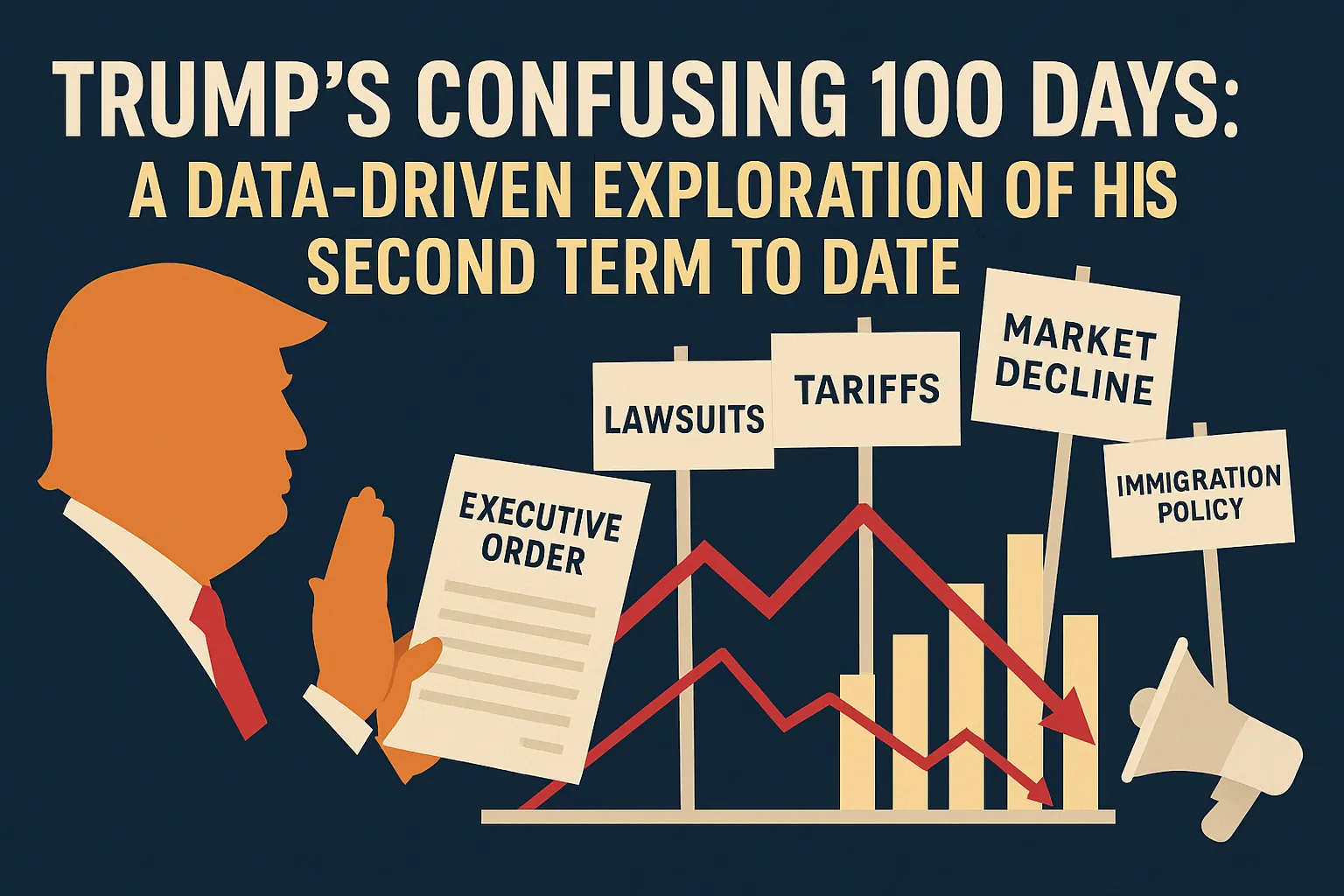Donald Trump began his second term with a barrage of executive orders, lawsuits, tariffs, and declining markets. Review significant happenings during his first 100 days
Donald Trump initiated his second term with an unprecedented wave of executive action, a plethora of lawsuits, economic volatility, and a drastically shifting immigration policy. Despite early declarations of success, the road ahead remains uncertain as approval ratings dip and global tensions rise.
Donald Trump’s Surprising First 100 Days – Explained in 8 Charts
Donald J. Trump’s return to the White House for a second term has already made history. Within his first 100 days, he has signed more executive orders than any modern president, imposed steep tariffs, and faced an unprecedented number of lawsuits. Markets have tumbled, immigration arrests have spiked, and emissions trends have reversed. In short, his early presidency reflects disruption on nearly every front.
Record Executive Orders Define Trump’s Governance
On his very first day back in office, Trump signed a record 26 executive orders—and the wave didn’t stop there. These orders range from symbolic political statements to directives with real legislative power, especially in areas like immigration, energy, and drug pricing. To Trump, executive orders have become a means of governance that avoids negotiation with Congress and proposes policy.
Legal Storms Increase
Trump’s speed of policymaking has resulted in a wave of lawsuits. The actions he has taken–massive draconic cuts in federal funding, cuts to the federal workforce, a radical reshaping of immigration policy, and tariffs–have immediately prompted legal challenges. Unlike past administrations, where such suits arose after months or years of deliberation, Trump’s policies are drawing instant judicial scrutiny.
Tariffs Surge — But Who’s Paying?
At the heart of Trump’s economic policy lies the tariff — taxes on imported goods. While proponents of the administration will say that these tariffs protect U.S. industries, challenges suggest that the costs ultimately fall on U.S. businesses and consumers. And although federal customs revenue has skyrocketed, with the spread of global supply chains, and the increased costs of these products, the debate on whether this approach works remains controversial.
Dollar Weakens Amid Global Uncertainty
The dollar has seen significant devaluation under Trump’s leadership. After announcing broad tariffs on April 2, the dollar took one of its steepest dives in years. Though he later reversed the policy temporarily, the currency has yet to recover. While a weaker dollar can boost U.S. exports, it also raises inflation risks and reflects market unease.
Markets Falter as Uncertainty Rises
Trump once hailed the stock market as a key indicator of his success. This time, however, the markets tell a different story. Since his second inauguration, the S&P 500 has dropped more than 7%, the worst decline of a new presidency since Gerald Ford in 1974. His comments about tariff threats and interest rate movement added to investor angst.
Diplomatic Communication Declines
State Department press briefings have steadily declined, demonstrating a detour from transparent foreign policy communication. The Trump Administration has suggested cutting foreign aid and reorganizing international development programs; critics say this undermines America’s world influence.
Cuts to Scientific and Medical Research
The Trump administration has made significant cuts to the National Institutes of Health (NIH), targeting research on transgender healthcare, racial disparities, and vaccine development. These cuts reflect both budgetary priorities and ongoing conflicts with academic institutions. The result? A general decline in U.S. research investment.
Rhetoric vs. Reality: The 100-Day Rally
Despite these challenges, Trump recently celebrated his 100-day mark at a rally, calling it “the most successful in American history.” He praised loyal crowds, repeated familiar claims, and cast his eye on the future. Yet, beneath the confident exterior is a more nuanced reality: an unpredictable presidency characterized by strife, policy whiplash, and a long, difficult road ahead.
Now that Trump is starting the remaining 1,361 days of his second term, he is starting with a public stranding its ground and more uncertainty ahead in terms of challenges. Whether the administration will successfully utilize disruption, not just to him or to the movement he claims to lead, but to initiate true policy change remains to be seen—but it’s likely the first hundred days will lay a contentious tone for the next three years.

